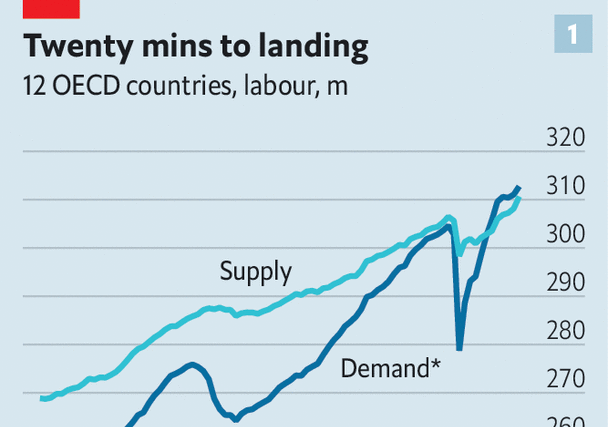If central bankers are to defeat inflation, they must cool the labour market. For two years rich-world wage growth has added to corporate costs, sending prices relentlessly upwards. But as they began raising interest rates to slow the economy, policymakers hoped for an even rosier outcome. They wanted to achieve a “soft landing”, which involves both bringing down inflation, and doing so without mass job losses. It is a lot to ask of a tool as blunt as monetary policy.
Are they succeeding? The question is almost certainly one that officials at the Federal Reserve will be asking when they meet on September 19th and 20th. And so far the evidence suggests that—against widespread expectations—labour markets from San Francisco to Sydney are co-operating.
Central bankers started to raise rates at a time when demand for labour had almost never been so strong (see chart 1). Last year the unemployment rate across the oecd club of mostly rich countries, measuring the share of people in the labour force who would like a job, was a shade under 5%, close to an all-time low. Excess demand for labour showed up in a surge in unfilled vacancies, which reached an all-time high. Workers bargained for higher wages, knowing that they had plenty of options.
The scale of the task central bankers set themselves was illustrated by history. Research by Alex Domash and Larry Summers, both of Harvard University, found that there had never been an instance in which the American vacancy rate had fallen substantially without unemployment rising significantly. Last year Michael Feroli of JPMorgan Chase, a bank, studied the record and noted that “whenever the vacancy rate goes down a little it goes down a lot, and the economy lands in recession.”
To assess progress in rich-world labour markets, we have assembled data from the oecd and Indeed, a listings website, covering 16 countries. In this group, employers have reduced open vacancies by more than 20% on average from their peak—a historically rapid decline. Some countries, such as France, have seen relatively modest falls of 10% or so. In others, such as Canada, Japan and Switzerland, unfilled job postings are down by a quarter or more.

Declining vacancies are helping trim wage growth. In America the annual rate of pay rises has slipped from 6% in late 2022 to below 5% today (see chart 2). Canadian wage growth is also falling fast. The story is less clear elsewhere, not least because the quality of the earnings data is worse. In Germany and Italy wage growth has probably stopped rising, though there remain pockets of concern, including in Britain—which might explain why the Bank of England, which also meets this week, is expected to raise rates again.
For policymakers, this success would feel a little soiled if it came with a sharp rise in joblessness. According to rules of thumb for America discussed by Messrs Domash and Summers, in normal times you would expect a 20%-plus fall in vacancies to come alongside a rise in unemployment of three or so percentage points within a year.
In reality, a year or so after vacancies started heading down, something else appears to be happening. Recently the unemployment rate in the oecd has held steady. Job growth, at 500,000 a month across the rich world, is about as fast as it was in the second half of last year. The working-age employment rate—the share of people aged 16-64 who are actually in a job—has risen to an all-time high in around half of oecd countries. Even places known for high unemployment, such as Italy and Portugal, have found jobs for an unprecedented share of their working-age population.
Why are labour markets breaking the historical rule? One possibility relates to “the great resignation” during covid-19. In 2021, spooked by stories of employees quitting to start crypto firms and write novels, some employers may have put up job vacancies as an insurance policy. Now, as fewer folk quit their jobs, they are taking them down again.
A second possibility relates to “labour hoarding”. During lockdowns in 2020 many companies let workers go, only to struggle to rehire them when the economy opened up. Bosses do not want to make the same mistake twice. So today, even as the economy slows and firms cut job adverts, they are trying to hang on to existing workers.
Central bankers still have a task on their hands, as inflation in many places remains uncomfortably elevated. Even in America and Canada, demand for labour is high relative to supply. Across the rich world wage growth exceeds productivity growth, adding to the pressure. And Messrs Domash and Summers could still be proved right if unemployment jumps in the coming months. But after two years of bad inflation data, and warning after warning that their strategy was sure to fail, policymakers nevertheless have reason to be hopeful. ■




The Most Read
Сryptocurrencies
Bitcoin and Altcoins Trading Near Make-or-Break Levels
Financial crimes
Thieves targeted crypto execs and threatened their families in wide-ranging scheme
Financial crimes
Visa Warning: Hackers Ramp Up Card Stealing Attacks At Gas Stations
News
Capitalism is having an identity crisis – but it is still the best system
Uncategorized
The 73-year-old Vietnamese refugee is responsible for bringing Sriracha to American consumers
Uncategorized
Electric Truckmaker Rivian, Backed By Amazon, Ford, Raises Whopping $1.3 Billion